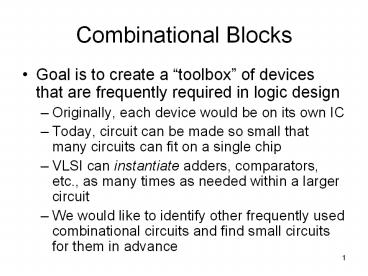Combinational%20Blocks PowerPoint PPT Presentation
Title: Combinational%20Blocks
1
Combinational Blocks
- Goal is to create a toolbox of devices that are
frequently required in logic design - Originally, each device would be on its own IC
- Today, circuit can be made so small that many
circuits can fit on a single chip - VLSI can instantiate adders, comparators, etc.,
as many times as needed within a larger circuit - We would like to identify other frequently used
combinational circuits and find small circuits
for them in advance
2
Equality Comparator
- Want a signal, EQ, that is 1 iff two 4-bit
numbers, A and B, are equal. Under what logic
conditions are A and B equal? - Equal if a3 b3 AND a2 b2 AND a1 b1 AND a0
b0 - Which gate performs an equality comparison?
- XNOR!
How many gates are required to implement an n-bit
parallel comparator?
l levels l log2(2n)
n ½ 2l
Total of gates
3
A Series Comparator Implementation
How many gates are required to implement an n-bit
series comparator?
- Comparing first two bits 3 gates
- Comparing each additional bit 2 gates
- After comparing the first 2 bits, there are n-2
bits left to compare for a total of 2(n-2) gates - Total number of gates required 2(n-2) 3 2n
1 - Series and parallel implementations require
the same number of gates! Is there a reason to
prefer one implementation over the other?
4
Magnitude Comparator
- Want to design a signal, AgrB, that is 1 iff A gt
B (A and B are 4-bit numbers). Under what logic
conditions is A gt B? - A gt B if a3 1 and b3 0
- A gt B if a2 1 and b2 0
- A gt B if a1 1 and b1 0 and a2 b2 and a3
b3 - A gt B if a0 1 and b0 0 and a1 b1 and a2
b2 and a3 b3
and a3 b3
5
Programmable Logic Devices
- Idea is to have a device that can easily and
quickly be configured to perform any
combinational function - Many designs are first realized on programmable
devices - Implementation is quick and cheap to facilitate
debugging - Not as efficient as custom gate implementation
- Early devices could only be programmed once
todays devices can be reprogrammed multiple times
6
- First programmable device Programmable Logic
Array (PLA) - AND/OR array
- Each junction contains a fuse functions are
realized by blowing fuses - Example
X represents a fuse that is not blown
7
Decoders
- In general, a decoder takes as input a code
word with a few number
of bits and outputs a
corresponding code word with a larger number
of bits - Binary decoder converts from n to 2n bits
- Description When enable is asserted, exactly
one output signal is asserted, based on the
binary code on the input signals
Each output is a minterm!
8
Decoder Circuit
Symbol
9
Cascading Decoders
Creating a 4-to-16 decoder from five 2-to-4
decoders
Creating a 3-to-8 decoder from two 2-to-4
decoders
10
Implementing Functions with Decoders
- Any n-variable function can be implemented with a
n-to-2n decoder! - Recall that each decoder output is implemented as
a minterm of the input variables - Recall that any function can be implemented as a
sum of minterms - Therefore, any function can be implemented as a
sum of decoder outputs!
11
Encoders
- Opposite of decoders an encoder takes as
input a
code with a large number of bits and
outputs a
corresponding code with a small
number of bits - Most common encoder maps a 2n one-hot code to an
n-bit binary number, where the binary number
represents the input number that is asserted - What if all input signals are deasserted?
Requires additional output, usually called A
(active) that is asserted if at least one input
is asserted
12
- What if we want to allow multiple inputs
to be asserted
simultaneously and output
the asserted input number with the
highest priority? - This task is performed by a priority encoder
- An easy way to implement use our existing
toolbox specifically, make use of the encoder
that weve already designed - Need to add a circuit that will resolve priority
assert output signal corresponding to asserted
input with highest priority
13
Multiplexer (Mux)
- A mux is a digital switch
- The output copies one of n data inputs, depending
on the value of the select inputs - Implementation
Product terms are mutually exclusive!
14
Building large multiplexers from smaller
multiplexers (and other blocks)
using four 4-input muxes and 1 2-to-4 decoder
15
using five 4-input muxes
16
Implementing Functions With a Multiplexer
- We can implement an n-variable function using an
n-select (2n-input) mux
17
- We can do better we can implement an n-input
function with a (n-1)-input mux!
18
In Class Exercise
- Implement the following 3-input function using a
single 4-input mux
19
Demultiplexer (demux)
- A demux connects an input signal to one of
several output signals, depending on the value of
the select signals - How to implement?
- TT should look very familiar
- Use a decoder!
20
Tri-State Gates
Other tri-state devices
21
This looks familiar
- Is it ok to connect the outputs of tri-state
devices? - C1 C0 1 and D1 ? D0 ? bad!
- C1 C0 0 ? Q ?
- C1 C0 ? OK!
- Typically, tri-state control signals are one-hot
- Results in exactly one device connected to the
output at a time - Multiple devices can communicate over a single
shared wire - Only one device is allowed to drive the wire at a
time - A functional group of such wires is called a bus.
22
- Tying it all together

